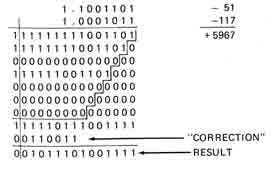Bit-Slice Design: Controllers and ALUs
by Donnamaie E. White
Copyright © 1996, 2001, 2002 Donnamaie E. White
- Pre-Introduction
- Selection of the Implementation
- Microprogramming
- Advantages of LSI
- The 2900 Family
- Language Interrelationships
- Controller Design
- Constructing the CCU
- Sequential Execution
- Multiple Sequences
- Start Addresses
- Mapping PROM
- Unconditional Branch
- Conditional Branch
- Timing Considerations
- Pipelining
- Improved Architecture
3. Adding Programming
Support to the Controller
- Expanded Testing
- Subroutines
- Nested Subroutines
- Stack Size
- Loops
- Am29811
- Am2909/11
- CASE Statement (Am29803A)
- Microprogram Memory
- Status Polling
- Interrupt Servicing
- Implementation - Interrupt Request Signals
- Vector Mapping PROM
- Next Address Control
- Am2910
- Am2910 Instructions
- Control Lines
- Interrupt Handling
- Am2914
- Interconnection of the Am2914
6. The ALU and Basic Arithmetic
- Further Enhancements
- Instruction Fields
- Instruction Set Extensions
- Sample Operations
- Arithmetic -- General
- Multiplication with the Am2901
- Am2903 Multiply
The ALU and Basic ArithmeticLast Edit November 1, 1996; May 1, 1999 ; July 18, 2001 Multiplication with the Am2901To implement the above algorithm using the Am2901, the bits of the multiplier need to be examined one at a time. To perform the addition, shifting down is necessary to maintain alignment. To conditionally ass the multiplicand or 0, control of the source-operand pair (A, B) or (A, 0) is required and a method of conditional subtraction is needed. The functional diagram of the multiply operation is given in Figure 6-6. The actual schematic of a 16-bit Am2901 ALU is shown in Figure 6-7. Figure 6-6 Am2901A Multiply functional diagram
Figure 6-7 Specific interconnections for 16-bit multiply - ripple carry |
|
Q0
|
Ii
|
Source Pair
|
|
0
|
1
|
B + 0
|
|
1
|
0
|
B + A
|
RB3 = F3 EXOR Cn+4 EXOR Cn+3
The Algorithm
The microcode algorithm is as follows:

The result is across registers RB and Q, and the result is sign-extended to produce the proper number of bits so that multiplication with any two 8-bit two's complement numbers always produces a 16-bit result.
A sample 8 x 8 bit multiply is shown in Figures 6-8 and 6-9. Figure 6-9 shows the step-by-step walkthrough of the problem. Sample microcode is given in the Am2900 Family Data Book and the 2900 Family Study Guide. [Rare books at this point.]
Figure 6-8 Eaxmple: 8 x 8 bit multiply two's complement (B = -b, A = -a)

Figure 6-9 Walking through the Am2901A algorithm. The Am2901A algorithm takes advantage of added hardware to eliminate conditional jumps and therefore improve speed and reduce microcode

Am2903 Multiply
Unsigned Multiply
The Am2903 has unsigned multiplication implemented as one of its special functions. To perform multiplication, zero out the RAM register which, with Q, will contain the final result. If it is not already present, load the multiplicand into another RAM register. Load the multiplier into the Q register. The shift connection should tie the LSB (leasat significant bit) of the RAM register (S0) to the MSB (most significant bit) of the Q register (Q3) of the most significant slaice.
The actual microcode is two microwords
- load the Am2910 counter with the number of bits minus 1 (for 16 x 16, load with 15) and place the multiplier into Q
- use RCPT for the Am2910 to repeat the actual multiply operation
Two's Complement Multiply
The Am2903 has two other special functions which enable multiplication of a signed number. Two's complement multiply requires three microwords for any width multiplication.
The same initialization is required, with the multiplier being replaced into the Q register. The counter is this case is loaded with the number of bits minus 2 (for 16x16, load with 14). The repeast loop instruction is the same as before. The added step is effectively the sign bit "correction" which was the last step in the Am2901 algorithm. The required interconnect of the slices is the same as before, with the addition of the Z status line tied to Cin.

